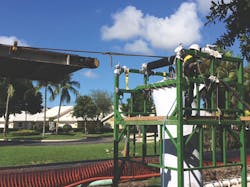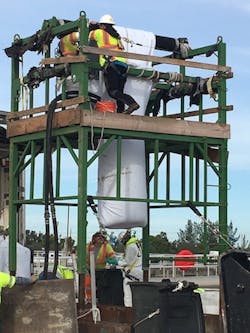CIPP Project Medley
About the author:
Jayne Shepherd is content marketing strategist for Aegion Corp. Shepherd can be reached at [email protected].
Cured-in-place pipe (CIPP) generally has been a solution for long runs of straight, small-diameter gravity sewer lines. However, it increasingly has been used in medium- to large-diameter pipeline projects. Large-diameter projects tend to present more complex issues, such as wet-out and jobsite logistics. However, with more than 45 years of experience and new innovations and improvements to the industry, large pipelines—including pressure pipelines—are being rehabilitated more and more with CIPP.
Today, the complexity and variety of projects encountered in the wastewater collections industry runs the gamut from rehabilitation of reinforced concrete pipe (RCP) with traditional CIPP to large interceptor rehabilitation using carbon-reinforced CIPP to pressurized ductile iron pipe rehabilitation using glass-reinforced CIPP. The most difficult of these jobs deal with pressure pipeline applications. However, recent advances have seen the industry pushing the envelope of what was once impossible with a higher success rate.
This is due to improvements in Insituform’s InsituMain CIPP system, a glass-reinforced product capable of standing up to the demanding requirements of pressurized systems. This CIPP system can negotiate bends and is engineered to restore existing pipelines, withstand both internal pressure and external load requirements, and eliminate leakage and corrosion. It is composed of an epoxy composite layer reinforced with glass materials and/or polyester fiber, depending on design specifications, and provides added strength and stiffness.
Additionally, a polypropylene layer on the inside of the pipe surface increases the pipe’s smoothness, reduces surface friction and provides an additional corrosion barrier for the pipe. The most recent iteration of the InsituMain CIPP system is certified to meet NSF/ANSI Standard 61 and provides better expansion capabilities and fit to host pipe (better adhesion). Other recent improvements to the system allow for longer shot lengths, improved liner flexibility, decreased resin usage and higher pipe burst strength (up to 1,400 psi). The E-CR fiberglass also offers improved long-term corrosion resistance, which can be particularly beneficial in the highly corrosive environments of sewage systems.
These improvements have helped meet the growing needs of the pressure pipe industry for medium- and large-diameter pipelines.
Meeting Increased Consumer Demands
Located just south of Washington, D.C., Fairfax County is one of Virginia’s largest counties and has one of the nation’s largest sanitary sewer systems, collecting and treating up to 161 million gal of wastewater per day for about 340,000 residential and business connections. Roughly 20 years ago, the county installed dual 36-in. prestressed concrete cylinder pipe (PCCP) sanitary force mains. At that time, the county only put one of these lines in service and kept the second line capped and flooded for future use.
With a growing population, Fairfax County needed to put the second 36-in. line into service. However, upon inspection it was discovered that areas of the pipe had degraded over time and it was unsuitable for reinstatement without first addressing these issues. It was decided a combination of dig-and-replace and CIPP rehabilitation was the best means of repair. Taking into consideration the internal pressures and the location of the line, the county and its engineers determined which sections would be repaired and which would be rehabilitated. Insituform worked with Garney Construction to rehabilitate the sections deemed suitable for CIPP repair.
A trenchless method of repair for some sections was necessary, as the force main ran through a park, down roadways and into a high school property. Due to these factors, a full dig-and-replace would have been a major disruption to the surrounding residence and businesses. Utilizing the InsituMain CIPP product and epoxy resin, Insituform installed nine liners to rehabilitate 4,125 ln ft of 36-in. PCCP pipe.
Meeting Design Requirements
The Santa Ana River Watershed (SAWPA) Inland Empire brine line was constructed between the 1970s and 1990s, and provides a facility for exporting salt from inland areas to the ocean. Salty wastewater from industrial facilities is redirected from the local wastewater treatment plant to the line, reducing the salt discharged from treatment plants into the Santa Ana River, helping to protect the plants and animals dependent on lower salt content in the water, and helping to reduce the salt percolating into inland and groundwater basins.
In 2011, a brine spill was reported near the intersection of Temescal Canyon Road and Cabot Road in Corona, Calif. Subsequent excavation of the line in this location revealed the pipeline failed with a longitudinal crack along the invert through a joint. At the time of failure, the pipeline had an estimated pressure of 34 psi. The pipe material at this location was confirmed to be 24-in. PVC IPEX Centurion DR 51 pipe with an internal pressure rating of 80 psi. The pressure rating and sensitive contents of the line meant that the solution had to meet rigorous specifications.
In September 2012, SAWPA convened a panel of experts who evaluated the pipeline condition and recommended the use of cured-in-place pressure pipe to repair the existing PVC pipeline. Insituform implemented the rehabilitation of the brine line in 2017 based on the engineering recommendations of the expert panel. At its end, the project included almost 11,000 ft of 24-in. pipe, engineered to exacting specifications using the reinforced CIPP product.
Preventing Risk in a Sensitive Area
The city of West Palm Beach, Fla., embarked on one of the largest projects of its kind in 2016 to rehabilitate a more than 40-year-old PCCP force main using a fiber-reinforced cured-in-place pipe solution. A condition assessment of the primary force main carrying the entire sewage flow for the city of West Palm Beach and the town of Palm Beach concluded that the number of pipe segments with broken wire wraps—with breaks ranging from 5 to 100 broken wires per 20-ft segment—provided a significant risk of failure.
With a maximum average operating pressure of 25 psi and surge pressure of 35 psi, the pipe required a structural solution. For this type of project, open-cut or traditional slip-lining is normally used. However, open-cut was ruled out due to project costs and disruption to homeowners and the golf course due to removal and replacement. It also was determined that traditional slip-lining would result in too great of a diameter reduction for the flow capacity of the line. Together with Jacobs Engineering and West Palm Beach, the project was designed with materials to withstand the required pressure rating of the 48-in.-diameter line. CIPP was selected to rehabilitate the pipe; it is one of the first rehabilitation projects to use fiber-reinforced CIPP at this pressure, diameter and length.
The bypass and installation footprint traveled across the fairways and through the ponds of Bear Lakes Country Club, a condo parking lot and common grounds, and roughly a dozen backyard easements of houses on the golf course property, as well as along a canal and through a middle school easement. Minimizing risk to both homeowners and the community were so important to the success of the project that a public relations firm was contracted to help with communication.
The CIPP liner was impregnated with epoxy resin at Insituform’s wet-out facility in Indianapolis and then shipped to Florida for installation. Once received, the tube was able to be put in the ground at a rate of about one shot per week using water inversion and hot water cure. The project was broken up into six separate shots, with the largest install measuring more than 1,100 ln ft in length.
Post-installation, the force main was reconnected to the rest of the system and pressure testing was commenced to verify that the line could withstand the normal 25 psi operating pressures and 35 psi surge pressures. The line was put back into service in early October 2016 after successful pressure testing.
Fast-Tracking Design & Rehabilitation
In fall 2017, construction work began to remediate approximately 1,000 ln ft of a return activated sludge (RAS) line at the East Central Regional Water Reclamation Facility. Part of the same system as the West Palm Beach project, the twin 30-in. RAS lines were having new 42-in. aeration lines installed directly above them.
As the construction progressed, there were growing concerns about not only the condition of the existing 30-in. ductile iron RAS lines, but also the impact of construction activities of laying the new 42-in. aeration lines directly above the RAS lines and the ability to perform future maintenance, replacement or rehabilitation on the RAS lines once the lines were installed. With this in mind, the design engineers at Hazen were tasked with fast-tracking the design and rehabilitation of the twin RAS pipelines.
To prevent delays in construction activities, an accelerated timeline for procurement and remediation of the RAS lines was implemented. Insituform was selected to perform rehabilitation for the project using the InsituMain CIPP system. The work was subcontracted through Poole & Kent, the general contractor working on site as part of the larger overall plant construction project, and lining activities commenced in July 2017. The CIPP lining portion was completed just a few weeks later.
Since shutting down these lines was not an option, the project required extensive bypass with high-density polyethylene (HDPE) lines set up above ground, rerouting the flow of sludge. With their proximity to the access pits, existing aeration basins and clarifiers, the bypass lines made for a tight jobsite footprint.
After the bypass was set up, the tube was installed using water and hydrostatic head pressure, and inverted the tube through the cylindrical host pipe. This installation also included one of the more recent approaches to CIPP lining in pressure pipe applications—fiberglass reinforced plastic (FRP) spool pieces were used as end terminations to terminate the CIPP liner. When the epoxy resin of the CIPP marries with the bonding agent of the FRP and the liner is cured, an aggressive CIPP/FRP bond is formed.
The last step prior to installation of the mechanical fittings was a hydraulic pressure test to verify that the liner had been installed properly and could withstand the internal 25-psi operating pressures. The liners were pressure-tested according to ASTM F1216, and both installations passed the 50-psi pressure test without issue.
Conclusion
The projects highlighted show the recent increased capabilities of fiber-reinforced CIPP for pressurized applications. Not only has the scope of the fiber-reinforced system been enhanced, but it also provides benefits to the customer and communities at large by helping to meet increased demand and more rigorous design requirements, preventing risk in sensitive environments, and fast-tracking project design and installation.




